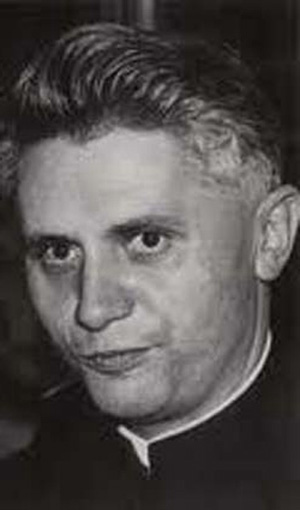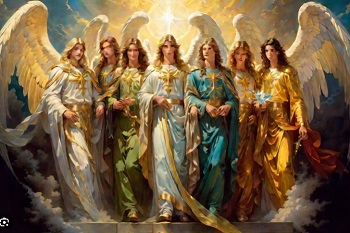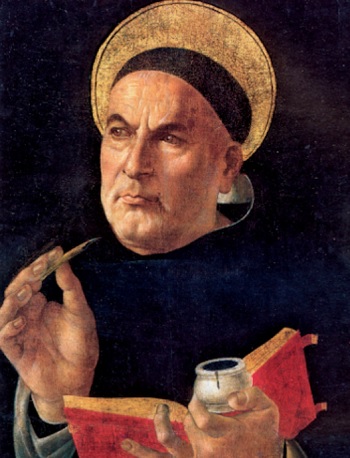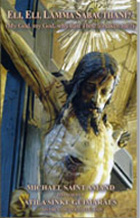Traditionalist Issues
 |
 |
 |
 |
 |
 |
 |
Dialogue Mass - CXXXVIII
The ‘Maladie Catholique’
What exactly was the pre-Vatican II malady for which the Council was the supposed cure? Fr. Joseph Ratzinger spelled it out in no uncertain terms:
“Towards the end of the 19th century French psychiatrists coined the phrase ‘maladie Catholique,’ by which they meant that special neurosis that is the product of a warped pedagogy so exclusively concentrated on the 4th and 6th Commandments that the resultant complex with regard to authority and purity renders the individual so incapable of free self-development that his selflessness degenerates into a loss of self and a denial of love.”1
 Before proceeding, it will be useful to recall that Ratzinger admitted to having been deeply influenced in his formative years by these ideas through the work of the German theologian, Fr. August Adam. (See article 15) In the above quote, he repeated the standard narrative that was – and still is – circulating in seminaries and progressivist circles.
Before proceeding, it will be useful to recall that Ratzinger admitted to having been deeply influenced in his formative years by these ideas through the work of the German theologian, Fr. August Adam. (See article 15) In the above quote, he repeated the standard narrative that was – and still is – circulating in seminaries and progressivist circles.
This posits that the Church’s traditional teaching on morality impairs psychological and emotional development, leading to an anxiety-inducing and guilt-ridden “neurosis” based entirely on oppressive relations of power. These deleterious effects were supposed to have been caused by the “rigidity” of the moral ethics presented in the Manuals. The charge, in other words, is that the pre-Vatican II faithful were emotionally scarred and psychologically damaged by the “Manualist tradition.”
But we are dealing in reality with the post-Vatican II “psychologizing” of Catholicism in the form of a heady mix of Freudian-Marxist analyses. It was Freud who attacked the authority of the “Father” (4th Commandment) and the prescriptions of the Moral Law (6th Commandment); while Marx preached emancipation from all authority structures, including that of the family. After Vatican II, spiritual counsel and pastoral care were contaminated with these false and harmful influences enabled by Gaudium et spes § 62, which states:
“In pastoral care, sufficient use must be made, not only of theological principles, but also of the findings of the secular sciences, especially of psychology and sociology, so that the faithful may be brought to a more adequate and mature life of faith.”
Scholasticism displaced by inexact science
In place of the teachings of St. Thomas Aquinas, the theories of Freud, Jung and Carl Rogers were freely circulating in seminaries and Catholic educational establishments. And without providing clearly defined theological principles drawn from the Scholastic Manuals, Gaudium et spes § 62 let the Church be inundated by the secular influence of clinical psychology,2 even to the point of appropriating it within the sphere of theology.
In the midst of this welter of confusion, it is only to be expected that many practitioners of psychology who denied the Church’s teaching on morality saw themselves as competent to override the Catholic position on this issue.
Two examples illustrate this point, though many more could be provided.
First, when Humane vitae was promulgated in 1968, it was heavily criticized by some professional bodies for failing to comply with modern standards of psychology. Its shortcomings were listed as having an inadequate view of the human person; “employing a faulty psychology that was no longer acceptable as adequate,” not understanding the complexity of psychological factors in the “total experience of marriage,” and failing to recognize that “responsible human beings must develop a mature conscience.” 3
 Here, incidentally we can see the effects of the Council’s error in conceding legitimacy to psychology as a source of maturity in the faith. It has encouraged the widespread belief in the primacy of individual conscience over submission to God’s Law, which leads to the self-deification of man.
Here, incidentally we can see the effects of the Council’s error in conceding legitimacy to psychology as a source of maturity in the faith. It has encouraged the widespread belief in the primacy of individual conscience over submission to God’s Law, which leads to the self-deification of man.
Second, the prestige granted to psychology by the Council has led to its adoption by marriage tribunals as a basis for granting annulments, with the inevitable result that these have increased exponentially in the post-Vatican II era. With the new “personalist” approach to marriage outlined in Gaudium et spes, it was all too easy for judges to make arbitrary decisions on the supposed invalidity of marriages. Their method was to use psychological theories to judge the spouses’ “maturity” to enter freely into a contract or to maintain a relationship in a “psychologically mature” way.
This approach is enshrined in Francis’s Amoris laetitia where a lack of maturity, knowledge and freedom is simply presumed in most cases of granted annulments..
The influence of modern psychological theories can also be seen in the 1983 Code of Canon Law, which confused the proper hierarchy of the ends of marriage, demoting procreation from its status as the primary purpose intended by God, and unduly elevating Eros. This opened the floodgates to a veritable “culture of annulment,” which, in the estimation of many reasonable people, came to look very much like Catholic divorce by the back door.
With Vatican II, the ‘New Theology’ replaced Catholic Truth
An important consideration to keep in mind is that the shift from the pre-Vatican II method of training priests was not just a change of style from the Scholastic precision of the theological Manuals to a more “understandable” way of presenting the Faith to the modern world. All the historical evidence shows that, with the loss of the Scholastic Manuals, neo-modernists took advantage of the general ignorance of Aristotelian metaphysics that they themselves had brought about to promote their own ideas, relying on sympathetic Popes and Bishops to impose them on the faithful.
No matter how highly qualified they were in academic studies, they lacked the one quality required by Catholic priests for the effective transmission of the Faith in a sceptical world – the disposition of mind towards Truth that St. Thomas Aquinas called an “intellectual virtue” or habitus, and which can best be gained through familiarity with the systematic scientia of Scholastic philosophy and theology.
There is thus a wide chasm between the content of their theological formation and that of virtually all clergy before Vatican II, with the result that pre- and post-Vatican II Catholics are divided in their understanding of the Faith. Even where the same words are used, e.g. Church, Eucharist, sin and salvation, they now have different meanings.
We can thus speak of the emergence of a new religion brought into existence with the help of Vatican II and managed by Church leaders who are now largely ignorant of Aristotelian metaphysics and who, consequently, do not understand it or appreciate its value. As we shall see in the next article, Benedict XVI was a self-declared non-Thomist and proud of it.
The tendency among progressivist theologians to ridicule and destroy what they do not understand – a common characteristic of revolutionaries – is evident in the frequent gibes they make whenever the topic of Scholasticism is mentioned.
One example which springs to mind is the well-known caricature of Scholastic disputations involving “angels” and “pins.” Benedict’s former seminary mentor, Fr. Alfred Läpple, had obviously swallowed this cartoonish view: He accused Scholasticism of “degenerating into absurd logic-chopping exercises, as in the proverbial question raised by late Scholasticism of how many angels could fit on the head of a pin.” 4
 “Ridete quidquid est domi cachinnorum” (laugh with whatever laughter there is in your home). 5 It seems that the anti-Scholastics had their own lex ridendi (laughing law). When the guffaws have subsided and the farcical point is exposed to the cold light of day, the reality appears differently: The allegation has long been exposed as an old canard initiated by an early 17th-century Protestant clergyman, William Sclater, who reduced Scholasticism to a debate on “how many [angels] might sit on a needle's point.” 6 It cannot, therefore, be attributed to any Catholic Scholastic writer.
“Ridete quidquid est domi cachinnorum” (laugh with whatever laughter there is in your home). 5 It seems that the anti-Scholastics had their own lex ridendi (laughing law). When the guffaws have subsided and the farcical point is exposed to the cold light of day, the reality appears differently: The allegation has long been exposed as an old canard initiated by an early 17th-century Protestant clergyman, William Sclater, who reduced Scholasticism to a debate on “how many [angels] might sit on a needle's point.” 6 It cannot, therefore, be attributed to any Catholic Scholastic writer.
The myth, however, was spread by post-Reformation Protestants,7 and has been with us ever since, surviving in Catholic progressivist circles as a favorite expression with which to mock Scholasticism. But such sarcasm is unwarranted for, as Aquinas has shown, the location of non-corporeal beings, such as angels, is a philosophical question of fundamental importance, which he illuminates by the doctrine of Causality.8
This would have been self-evident before Vatican II; as an early 20th-century philosopher pointed out, Scholasticism has its own in-built system of coherence and rationality:
“A trained Scholastic theologian would first propose the question, and then he would marshal in its defence various arguments or proofs in a clear, concise, unadorned, logical, and unimpassioned form. He would solve the principal arguments brought forward in support of the contradictory doctrine. He would use the terminology which other theologians would accept and employ in exactly the same sense. He would not distract the mind by idle words or useless matter.”9
In other words, the theological Manuals took theology seriously. There was no allowance made for frivolity, triviality or time-wasting exercises involving disputations about angels dancing on the head of a pin.
 What is not often realized today is that the Scholasticism of the “Manualist tradition” was a superbly crafted pedagogical tool, a systemized method of presenting the truth of the Gospels in a rational and intellectually satisfying way by the application of rigorously precise and logical thinking. Many are unaware that, through the “perennial philosophy” contained in the Manuals, the Church has provided the means of guaranteeing that Truth, so that we can still believe with absolute confidence that the words spoken by Our Lord over 20 centuries ago are still relevant today.
What is not often realized today is that the Scholasticism of the “Manualist tradition” was a superbly crafted pedagogical tool, a systemized method of presenting the truth of the Gospels in a rational and intellectually satisfying way by the application of rigorously precise and logical thinking. Many are unaware that, through the “perennial philosophy” contained in the Manuals, the Church has provided the means of guaranteeing that Truth, so that we can still believe with absolute confidence that the words spoken by Our Lord over 20 centuries ago are still relevant today.
Those who charge that it is a failure and of no use for modern times have themselves not only failed to prove their point, but also have never brought forward a suitable alternative. There is no convincing reason why, given the chance, it cannot work in modern times. In fact, it is the only approach that works to make the Faith intelligible.
Their purpose was to displace Thomism and the Catholic philosophical heritage in order to replace them with their own views. These views, which revived characteristic elements of the Modernist heresy of the late 19th and early 20th centuries, need to be grasped in order to understand the current situation of the Church generally.
Under the influence of Vatican II and its official interpreters, progressivist theologians have been allowed to drift across an ocean of opinions without compass or chart (or, as some might prefer to say, without “fixed formulas”) towards no precise destination – except inevitable shipwreck of the Faith.
Having cast aside the basic structure of traditional Western philosophy, they have also jettisoned the fundamental philosophical insights it contains, which have buttressed the Catholic Faith and brought Christian Civilization to the world. Their rejection of the whole “Manualist tradition” was tantamount to destroying the record of essential knowledge required by priests not only for the understanding of the Faith but also for the practice of their ministry. The perpetrators might as well have consigned the Manuals to the flames, for they have produced the same effect in turning that knowledge to ashes.
Continued

“Towards the end of the 19th century French psychiatrists coined the phrase ‘maladie Catholique,’ by which they meant that special neurosis that is the product of a warped pedagogy so exclusively concentrated on the 4th and 6th Commandments that the resultant complex with regard to authority and purity renders the individual so incapable of free self-development that his selflessness degenerates into a loss of self and a denial of love.”1

Fr. Ratzinger was favorable to Freudism
This posits that the Church’s traditional teaching on morality impairs psychological and emotional development, leading to an anxiety-inducing and guilt-ridden “neurosis” based entirely on oppressive relations of power. These deleterious effects were supposed to have been caused by the “rigidity” of the moral ethics presented in the Manuals. The charge, in other words, is that the pre-Vatican II faithful were emotionally scarred and psychologically damaged by the “Manualist tradition.”
But we are dealing in reality with the post-Vatican II “psychologizing” of Catholicism in the form of a heady mix of Freudian-Marxist analyses. It was Freud who attacked the authority of the “Father” (4th Commandment) and the prescriptions of the Moral Law (6th Commandment); while Marx preached emancipation from all authority structures, including that of the family. After Vatican II, spiritual counsel and pastoral care were contaminated with these false and harmful influences enabled by Gaudium et spes § 62, which states:
“In pastoral care, sufficient use must be made, not only of theological principles, but also of the findings of the secular sciences, especially of psychology and sociology, so that the faithful may be brought to a more adequate and mature life of faith.”
Scholasticism displaced by inexact science
In place of the teachings of St. Thomas Aquinas, the theories of Freud, Jung and Carl Rogers were freely circulating in seminaries and Catholic educational establishments. And without providing clearly defined theological principles drawn from the Scholastic Manuals, Gaudium et spes § 62 let the Church be inundated by the secular influence of clinical psychology,2 even to the point of appropriating it within the sphere of theology.
In the midst of this welter of confusion, it is only to be expected that many practitioners of psychology who denied the Church’s teaching on morality saw themselves as competent to override the Catholic position on this issue.
Two examples illustrate this point, though many more could be provided.
First, when Humane vitae was promulgated in 1968, it was heavily criticized by some professional bodies for failing to comply with modern standards of psychology. Its shortcomings were listed as having an inadequate view of the human person; “employing a faulty psychology that was no longer acceptable as adequate,” not understanding the complexity of psychological factors in the “total experience of marriage,” and failing to recognize that “responsible human beings must develop a mature conscience.” 3

Freud & Jung, two heads of Psychiatry worshipped by progressivists
Second, the prestige granted to psychology by the Council has led to its adoption by marriage tribunals as a basis for granting annulments, with the inevitable result that these have increased exponentially in the post-Vatican II era. With the new “personalist” approach to marriage outlined in Gaudium et spes, it was all too easy for judges to make arbitrary decisions on the supposed invalidity of marriages. Their method was to use psychological theories to judge the spouses’ “maturity” to enter freely into a contract or to maintain a relationship in a “psychologically mature” way.
This approach is enshrined in Francis’s Amoris laetitia where a lack of maturity, knowledge and freedom is simply presumed in most cases of granted annulments..
The influence of modern psychological theories can also be seen in the 1983 Code of Canon Law, which confused the proper hierarchy of the ends of marriage, demoting procreation from its status as the primary purpose intended by God, and unduly elevating Eros. This opened the floodgates to a veritable “culture of annulment,” which, in the estimation of many reasonable people, came to look very much like Catholic divorce by the back door.
With Vatican II, the ‘New Theology’ replaced Catholic Truth
An important consideration to keep in mind is that the shift from the pre-Vatican II method of training priests was not just a change of style from the Scholastic precision of the theological Manuals to a more “understandable” way of presenting the Faith to the modern world. All the historical evidence shows that, with the loss of the Scholastic Manuals, neo-modernists took advantage of the general ignorance of Aristotelian metaphysics that they themselves had brought about to promote their own ideas, relying on sympathetic Popes and Bishops to impose them on the faithful.
No matter how highly qualified they were in academic studies, they lacked the one quality required by Catholic priests for the effective transmission of the Faith in a sceptical world – the disposition of mind towards Truth that St. Thomas Aquinas called an “intellectual virtue” or habitus, and which can best be gained through familiarity with the systematic scientia of Scholastic philosophy and theology.
There is thus a wide chasm between the content of their theological formation and that of virtually all clergy before Vatican II, with the result that pre- and post-Vatican II Catholics are divided in their understanding of the Faith. Even where the same words are used, e.g. Church, Eucharist, sin and salvation, they now have different meanings.
We can thus speak of the emergence of a new religion brought into existence with the help of Vatican II and managed by Church leaders who are now largely ignorant of Aristotelian metaphysics and who, consequently, do not understand it or appreciate its value. As we shall see in the next article, Benedict XVI was a self-declared non-Thomist and proud of it.
The tendency among progressivist theologians to ridicule and destroy what they do not understand – a common characteristic of revolutionaries – is evident in the frequent gibes they make whenever the topic of Scholasticism is mentioned.
One example which springs to mind is the well-known caricature of Scholastic disputations involving “angels” and “pins.” Benedict’s former seminary mentor, Fr. Alfred Läpple, had obviously swallowed this cartoonish view: He accused Scholasticism of “degenerating into absurd logic-chopping exercises, as in the proverbial question raised by late Scholasticism of how many angels could fit on the head of a pin.” 4

‘How many angels might sit on a pin’ - an idiotic criticism, for spiritual beings are not subjected to material limitations
The myth, however, was spread by post-Reformation Protestants,7 and has been with us ever since, surviving in Catholic progressivist circles as a favorite expression with which to mock Scholasticism. But such sarcasm is unwarranted for, as Aquinas has shown, the location of non-corporeal beings, such as angels, is a philosophical question of fundamental importance, which he illuminates by the doctrine of Causality.8
This would have been self-evident before Vatican II; as an early 20th-century philosopher pointed out, Scholasticism has its own in-built system of coherence and rationality:
“A trained Scholastic theologian would first propose the question, and then he would marshal in its defence various arguments or proofs in a clear, concise, unadorned, logical, and unimpassioned form. He would solve the principal arguments brought forward in support of the contradictory doctrine. He would use the terminology which other theologians would accept and employ in exactly the same sense. He would not distract the mind by idle words or useless matter.”9
In other words, the theological Manuals took theology seriously. There was no allowance made for frivolity, triviality or time-wasting exercises involving disputations about angels dancing on the head of a pin.

The Scholasticism of St. Thomas Aquinas:
clear, concise, & logical
Those who charge that it is a failure and of no use for modern times have themselves not only failed to prove their point, but also have never brought forward a suitable alternative. There is no convincing reason why, given the chance, it cannot work in modern times. In fact, it is the only approach that works to make the Faith intelligible.
Their purpose was to displace Thomism and the Catholic philosophical heritage in order to replace them with their own views. These views, which revived characteristic elements of the Modernist heresy of the late 19th and early 20th centuries, need to be grasped in order to understand the current situation of the Church generally.
Under the influence of Vatican II and its official interpreters, progressivist theologians have been allowed to drift across an ocean of opinions without compass or chart (or, as some might prefer to say, without “fixed formulas”) towards no precise destination – except inevitable shipwreck of the Faith.
Having cast aside the basic structure of traditional Western philosophy, they have also jettisoned the fundamental philosophical insights it contains, which have buttressed the Catholic Faith and brought Christian Civilization to the world. Their rejection of the whole “Manualist tradition” was tantamount to destroying the record of essential knowledge required by priests not only for the understanding of the Faith but also for the practice of their ministry. The perpetrators might as well have consigned the Manuals to the flames, for they have produced the same effect in turning that knowledge to ashes.
Continued
- Joseph Ratzinger, Principles of Catholic Theology: Building Stones for a Fundamental Theology, San Francisco: Ignatius Press, 1987 (a collection of essays written in the 1960s and ‘70s)
- We have seen in the previous article how psychology is used in assessing the suitability of candidates for the priesthood. It is also employed in many dioceses not only for clergy and religious in ongoing formation programmes, but also for pre-marriage preparation courses and the pastoral care of those already married.
- Kevin Gillespie SJ, ‘Psychology and American Catholicism after Vatican II: Currents, Cross-Currents and Confluences’, U. S. Catholic Historian, vol. 25, n.. 4, ‘American Catholics and the Social Sciences’ Autumn 2007, p. 119.
- Alfred Läpple, The Catholic Church: A Brief History, New York: Paulist Press, 1982, p. 45.
- Catullus, Carmen 31, line 14, urging his home-coming companions to give themselves over to laughter.
- William Sclater, D.D., An exposition with notes upon the first Epistle to the Thessalonians, London: W. Stansby, 1619, p. 385.
- For a historical overview of the topic, see Peter Harrison, ‘Angels on Pinheads and Needles’ Points’, Notes and Queries, Vol. 63, Issue 1, March 2016, pp. 45–47.
- St. Thomas Aquinas, Summa Theologiae, Part 1, q. 52, art. 3.
- J. O’Fallon Pope SJ, ‘A Plea for Scholastic Theology’, Journal of Theological Studies, vol. 5, n, 18, January 1904, p. 180.
Posted May 17, 2024

______________________
______________________
 Volume I |
 Volume II |
 Volume III |
 Volume IV |
 Volume V |
 Volume VI |
 Volume VII |
 Volume VIII |
 Volume IX |
 Volume X |
 Volume XI |
 Special Edition |


